DIY queen cell incubator
NOTE: This post is now redundant as I have designed, built and tested version 2 of my portable queen cell incubator. I’m leaving this post here for those who wanted to read some of the background information.
You can please some of the people all of the time, you can please all of the people some of the time, but you can’t please all of the people all of the time … so said John Lydgate (1370-1450).
And he wasn’t wrong.
This is something I’m particularly aware of writing a weekly post on beekeeping. Much like my talks to beekeeping associations, the ‘audience’ (in this case the readership) ranges from the outright beginner to those with way more experience than me.
An article, like the one last week, on transporting your first nuc home and transferring it to a new hive, is unlikely to be of much interest to an experienced beekeeper.
Conversely, a post on something esoteric – like Royal patrilines and hyperpolyandry – is probably going to be given a wide berth by someone who has recently started beekeeping {{1}}.
There’s no way I can write something relevant, interesting and topical for the entire breadth of experience of the readers {{2}}.
Going by the popularity of certain posts it’s clear that many readers are relatively inexperienced beekeepers.
The post entitled Queen cells … don’t panic! contains little someone who has kept bees for five years doesn’t or shouldn’t already know {{3}}. Nevertheless, it is one of the most popular pages over the last couple of years. It has already been read more times this year than all previous years {{4}}.
I suspect the majority of these thousands of viewings are from new(ish) beekeepers.
If you’re in this group then I suggest you look away now 😉 {{5}}
I’m going to discuss a pretty focused and specialised topic of relevance to perhaps a fraction of 10% of all beekeepers
The 10%
When I started beekeeping I was certain I would never be interested in queen rearing.
In fact I was so certain that, when repeatedly re-reading Ted Hooper’s book Bees and Honey, I’d skip the chapter on queen rearing all together.
By ‘queen rearing’ I mean larval selection, grafting, cell raisers, cell finishers, mini-nucs, drone flooding etc.
What a palaver!
All I wanted was a few jars of honey.
Oh yes, and slightly better tempered bees.
And perhaps a nuc to overwinter ‘just in case’.
What about a queen or two ‘spare’ for those swarms I miss?
A year or two later I had the opportunity – through the generosity of the late Terry Clare – to learn the basics of queen rearing and grafting.
A week later I had a go on my own.
Amazingly (though not if you consider the tuition) it worked 🙂 . I successfully reared queens from larvae I’d selected, transferred, produced as capped cells and eventually got mated.
It was probably the single most significant event in my experience as a beekeeper. I got my nuc to overwinter and I’ve gradually improved my bees through selecting from the best and requeening the worst. I know how to produce ‘spare’ queens, though need them less frequently as my swarm control has also improved 😉 {{6}}
I don’t know what proportion of beekeepers ‘actively’ rear their own queens. I suspect it’s 10% or less.
But even that select group aren’t the target audience for this post.
The target audience are queen rearers who need to incubate queens or queen cells for protracted periods (hours to days) without constant access to mains electricity.
Let me explain
The peripatetic beekeeper
I live on the remote west coast of Scotland {{7}} but keep the majority of my bees in Fife.
My apiaries in Fife are 30-40 minutes apart, and I drive past one on my way to my main apiary (in St Andrews). If I need a ‘spare’ queen in an out apiary (and have one in St Andrews) it adds over an hour to what is already a four hour beekeeping commute.
That’s an hour of my life I’ll never get back and something I’d really like to avoid {{8}}.
On the west coast beekeepers and bees are very thin on the ground. I’ve just started queen rearing here and (again) have a 45 minute commute between apiaries {{9}}. I’m working with another beekeeper and larvae are sourced from one and the cells are raised in another.
You can move frames of larvae about if you keep them warm and humid – a damp tea towel works well – at least if the times/distances are not too great.
But there’s an added complication … this area is Varroa free and I don’t want to be moving potentially mite-infested frames into the area. Nor do I want to deplete any of the donor colonies of brood frames.
All I want to move are a few larvae … but they’re a lot more fragile and sensitive.
So … two slightly unusual situations.
It seemed to me that my life would be a lot easier if I had some sort of portable queen and queen cell incubator.
My trusty honey warming cabinet
More than most events in beekeeping, the timing of the various stages of queen rearing is very clearly defined. You graft day old larvae and use the cells 10 days later. This timing currently defines the dates of my trips … except that sometimes there are diary clashes.
If my apiary with the cell raising colony was a mile away I could just go later in the day.
But it’s not … 🙁
Before I started this (temporary) life as a travelling beekeeper I’d sometimes needed to incubate queen cells that were near to emergence. Once the cell is capped you can put it in an incubator, either until you use it as a capped cell, or until the virgin queen emerges. You then requeen a colony using the recently emerged virgin queen.
This was clearly another option to make the diary clashes less of an issue – raise the cells and then incubate them (outside the hive) until emergence, and then use the queens.
I’d already used my trusty honey warming cabinet to incubate queen cells. When I built this I used an Ecostat chicken egg incubator element rather than a 100 W incandescent bulb. The Ecostat heaters are thermostatically controlled and do a pretty good job of maintaining a stable temperature, anywhere between the high 20’s (°C) and about 55°C.
There were two minor issues … the incubator needed a 240 V mains supply and was about the size of my car {{10}}.
However, it’s perfect if you need to incubate 800 queen cells at once 😉
What I needed was a smaller, more portable, ‘battery’ – or at least 12V – powered version … {{11}}
Beekeepers have short arms and deep pockets
One obvious solutions was to use a commercially available hen egg incubator. Brinsea are one of the market leaders and I know several beekeepers who use them as queen cell incubators.
Although they are usually mains powered, they actually have an integral transformer and run at 12V, so could be powered from a car cigarette lighter socket. Temperature and humidity are controlled. They start at about £80 and would need modifying to accommodate queen cells, or Nicot cages containing queens.
The beekeeping-specific commercial solution is the Carricell.
These are manufactured in New Zealand in three sizes – for 40, 70 or 144 queen cells. Swienty (and presumably others) sell the 70 cell variant {{12}} over here for €636 {{13}}.
Excluding VAT 🙁
Beekeepers are notoriously commendably parsimonious. Since I have an alter ego named Dr. Bodgit, it seemed logical to try and build my own.
For a little less that €636 …
And ideally less than £80 😉
But first I needed to know more about the influence of temperature on queen cell development.
Temperature and development
The usual temperature quoted for the broodnest is about 35°C. Numerous studies have shown that, although the temperature is never constant, it is always in the range 33-36°C {{14}}.
It is reasonably well known that temperature can influence the development time of honey bees. At lower temperatures, development takes a little bit longer.
More significantly, Jürgen Tautz and colleagues showed almost two decades ago that honey bee workers reared (as pupae) at low temperatures have behavioural deficiencies {{15}}.
For example, workers reared at 32°C showed reduced waggle dance activity when compared to bees reared at 36°C. Not only were they less likely to dance to advertise a particular nectar source, but they would dance less enthusiastically, performing fewer dance circuits.
In tests of learning and memory – for example associating smells with syrup rewards – bees reared as pupae at 32°C were also impaired when compared to bees reared at 36°C.
Tautz also demonstrated that bees reared at the lower temperature were more likely to go ‘missing in action’. They disappeared at a faster rate from the hive than the bees reared at the higher temperature. This strongly suggests their compromised memory or learning also had a negative influence on their survival. For example, in predator evasion, flight duration or the ability to find the hive.
OK … so temperature is really rather important for worker development.
Perhaps very accurate thermostatic control will be needed?
But what about queens?
There are good reasons to think that queen development might not be quite as sensitive to lower temperatures.
Queen cells are relatively rarely found in the centre of the broodnest. Those that are are often considered to be ‘supersedure cells‘, though location alone is probably not definitive.
Where are queen cells more usually found?
At the periphery of the broodnest, decorating the lower edges of the frame and even protruding down into the space below the bottom of the comb.
Logic suggests that these might well experience lower temperatures simply by being at or near the edge of the mass of bees in the cluster.
Perhaps queen development is less temperature sensitive?
Fortunately, I don’t need to rely on (my usually deeply flawed) logic or informed guesses … the experiment has been done {{16}}.
Chuda-Mickiewicz and Samborski incubated queen cells at 32°C and 34.5°C. Those incubated at the lower temperature took ~27 hours longer to emerge than those at 34.5°C (which emerged at 16 days and 1 hour after egg laying).
However, of the variables measured, this was the only significant difference observed between the two groups. Body weights at emergence were similar, as were the spermathecal volume and ovariole number.
In both temperature groups ~90% of (instrumentally) inseminated queens started laying eggs.
So perhaps development temperature is not so critical (for queens after all).
The cheque queen is in the post
Finally, I expected my bodged incubator would also be used to transport mated queens. There’s good evidence that these are very robust {{17}}. After all, you can get them sent in the post {{18}}.
Again, the experiment has been done 🙂
Jeff Pettis and colleagues investigated the influence of temperature on queen fertility {{19}} and concluded that incubation within the range 15-38°C are safe with a tolerance threshold of 11.5% loss of sperm viability {{20}}.
In addition, Pettis looked at the influence of high or low temperatures on adult viability (see graph above). Queens and workers survived for at least 6 hours at 25°C or 42°C. In contrast drones, particularly at high temperatures, ‘dropped like flies’ {{21}}.
Stand back … inventor at work
Version 1 of the incubator was built and has been used successfully.
It consists of a polystyrene box housing a USB-powered vivarium heating mat. This claims to offer three heating levels – 20-25°C, 25-30°C and 30-35°C – though these are not when confined in a well-insulated box where it can reach higher temperatures. I’m not sure I believe the amperage/wattage information provided and don’t have the equipment to check it.
I run it from a 2.1A car USB socket, or a similar one that plugs into the mains.
The battery pack in the picture above runs the Raspberry Pi computer that is monitoring the temperature {{22}}. It’s important to have accurate temperature monitoring and to do some trial runs to understand how quickly the box warms/cools. In due course all this wiring can either be omitted or built in … but it wouldn’t be a proper invention unless it looked cobbled together 😉
Inside the box is a lot of closed cell foam – some crudely butchered to accommodate Nicot queen cages – sitting on top of a large ‘freezer block’. This acts as a hot water bottle. There’s also a plastic tray holding some soggy kitchen towel to raise the humidity.
Define ‘success’
The box has been used for the following:
- transfer grafted larvae from an out apiary to a cell raising colony an hour away. Success defined by getting the grafted larvae accepted by the cell raiser.
- transport queen cells up to 7 hours by car {{23}}. Success defined by requeening colonies with the cells.
- transport and maintain virgin queens for 7-10 days. These emerged in the incubator and then accompanied me back and forth before being used. All are now in hives and out for mating.
While powered – either in the house or the car – the box is easy to maintain at an acceptable temperature for extended periods, though it takes some time to reach the operating temperature.
Even when opening the lid as queen cells are added/removed the temperature fluctuates by no more than 2-3°C. The graph above was generated from temperature readings taking queen cells from one apiary to another.
I’ll describe maintaining queens for extended periods in an incubator (with no attendant bees) in a future post.
The future
This really is a bodged solution.
At the moment the temperature has to be changed manually to keep it within the 32-35°C range. This might only be every few hours, depending upon how frequently the box is opened.
The combination of the insulation and the ‘hot water bottle’ freezer block means it can be left unattended overnight.
However, it really needs to have automatic temperature control. This should be trivial to add but will require more time than I have at the moment and for the box to be empty. It’s accompanying me on an exotic holiday to Glenrothes for the next three days {{24}} and will be in use for much of July as I start to make up nucs for overwintering.
So … as promised, an inelegant but working solution for a fraction of the 10% of beekeepers who rear queens.
At a fraction of the price of a commercial one 🙂
STOP PRESS – update 7th September ’21
I now have a working solution with proper thermostatic temperature control. It’s currently going through a final series of tests. I strongly suggest you don’t follow the botch-up design described above, but wait for another post on this subject sometime this winter. It’s possibly to build a queen cell incubator with fully automatic temperature control of ±0.5°C that will work at home or in a vehicle for about £60.
STOP PRESS – update 26th November ’21
Full details of version 2 have now been published and this page is left here for historical reasons only …
{{1}}: And many others … this post is languishing way down the leader reader board. It’s an interesting topic. Show it some love :-)
{{2}}: Or sometimes for any of them?
{{3}}: Perhaps through bitter experience.
{{4}}: I reckon I could map the northwards spread of swarming activity by geolocating the IP address of readers of this page.
{{5}}: Actually, don’t. Stick around … there’s some science about bees and temperature coming up.
{{6}}: A bit …
{{7}}: And, before you ask, we do have electricity – mains and solar – together with all the modern essentials like fibre broadband. And I only have to walk 500 metres to fetch water from the burn to wash with.
{{8}}: Yes, I could go to the out apiary on my return journey, but there are (many) times when that isn’t practical or convenient.
{{9}}: More if the roads are clogged with holiday caravans.
{{10}}: Or, more precisely, the size of 6-8 supers stacked in two piles.
{{11}}: A bigger car and a long extension lead wouldn’t work.
{{12}}: About 60 more cells than I need.
{{13}}: About €630 more than I’m prepared to pay.
{{14}}: This is the broodnest temperature i.e. when rearing larvae/pupae … the temperature is lower when the colony is broodless in the winter.
{{15}}: Tautz J, et al., (2003) Behavioral performance in adult honey bees is influenced by the temperature experienced during their pupal development. Proc Natl Acad Sci U S A. 100:7343-7347. https://doi.org/10.1073/pnas.1232346100
{{16}}: Chuda-Mickiewicz, Bożena, and Jerzy Samborski (2015). ‘The Quality of Honey Bee Queens from Queen Cells Incubated at Different Temperatures’. Scientorum Polonarum ACTA Zootechnica 14 : 25–32. (PDF)
{{17}}: Relatively speaking …
{{18}}: Where transport temperatures can fluctuate wildly.
{{19}}: McAfee, A. et al., (2020) ‘Vulnerability of Honey Bee Queens to Heat-Induced Loss of Fertility’. Nature Sustainability 3 : 367–76. https://doi.org/10.1038/s41893-020-0493-x. This is behind a paywall … as an alternative go for the preprint server copy lodged with bioRχiv.
{{20}}: This 11.5% was considered acceptable after quantifying sperm viability in failing queens.
{{21}}: Literally … Pettis also studied thermal shock of fruit flies (Drosophila melanogaster) which showed no sex-biased heat mortality and rapidly became moribund after 3-4 hours at 42°C.
{{22}}: I don’t have space to describe this – it’s an RPi Zero with a couple of DS18b20 1wire temperature probes. The temperature is logged every minute and uploaded to ThingSpeak. If it’s running you can view it here. I can view the temperature on my phone. I also have a clock/thermometer with remote sensor as a backup. The yellow PostIt note reminds me that this under-reads by almost 1°C. Not ideal, but useful if there’s no network coverage.
{{23}}: A nightmare journey including a 3 hour detour due to road closures.
{{24}}: And if you know Glenrothes you’ll know that ‘exotic’ is a word rarely used in the same sentence …
… for understandable reasons.
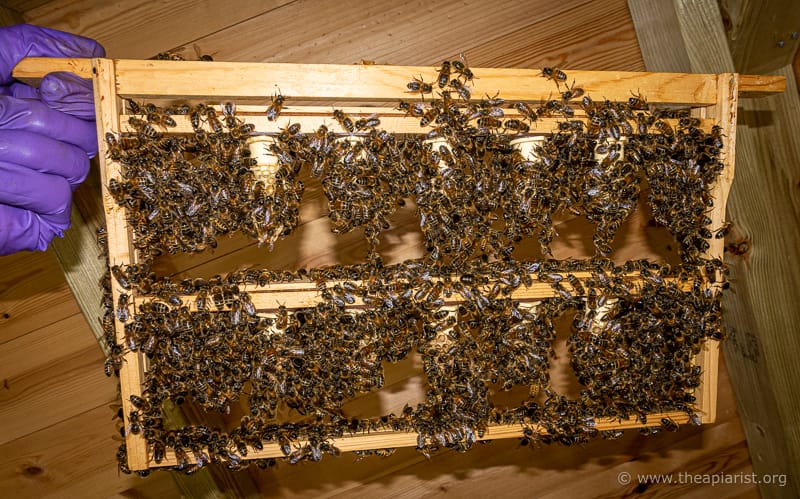
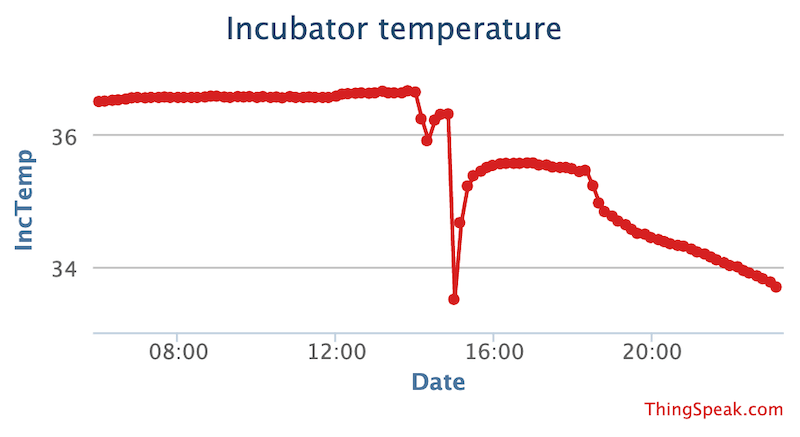
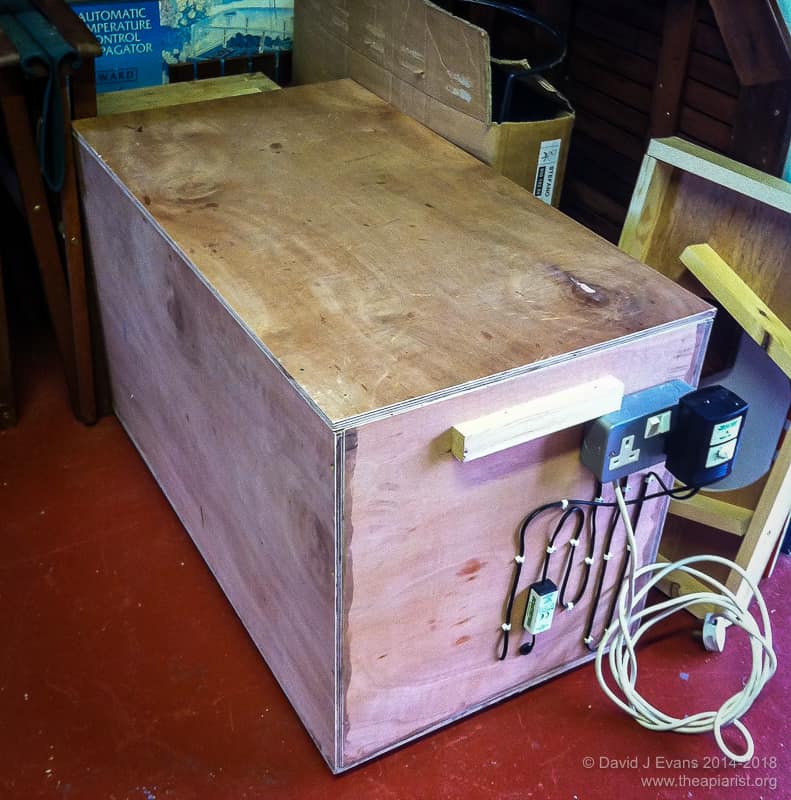
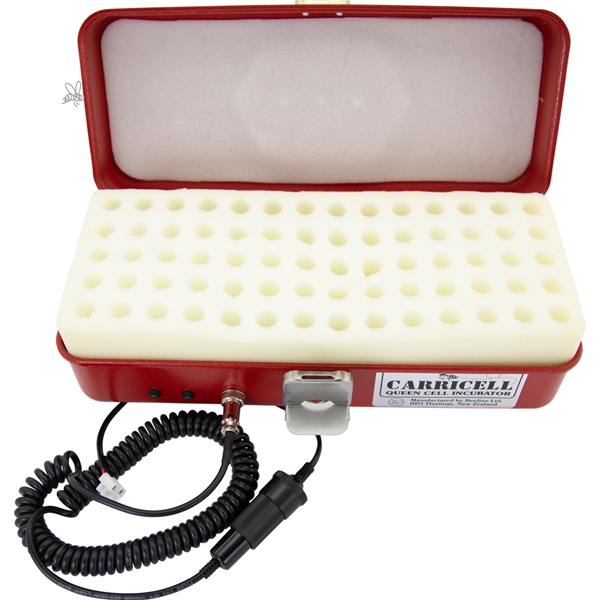
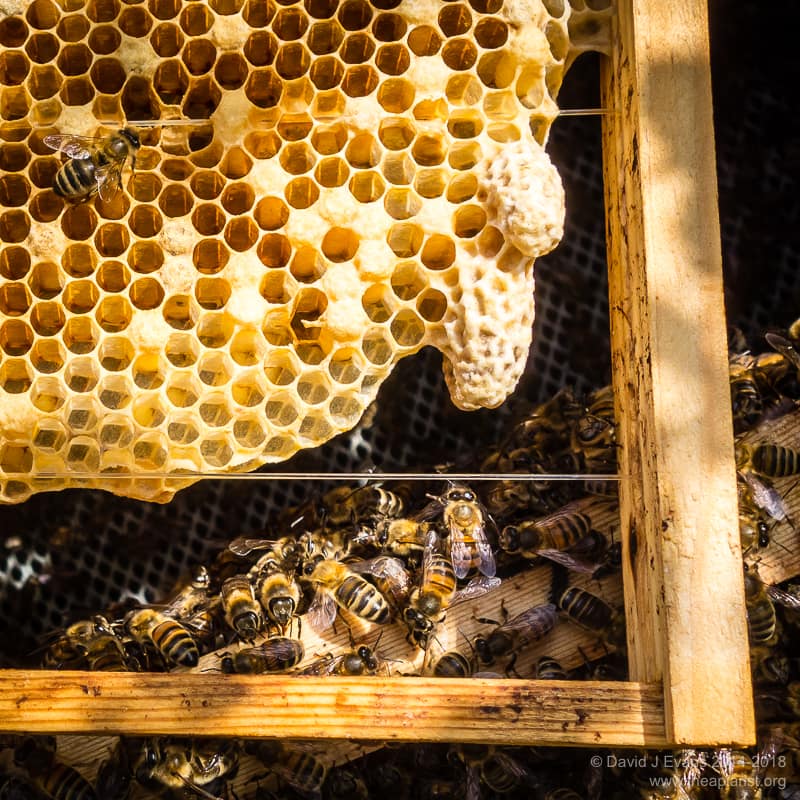
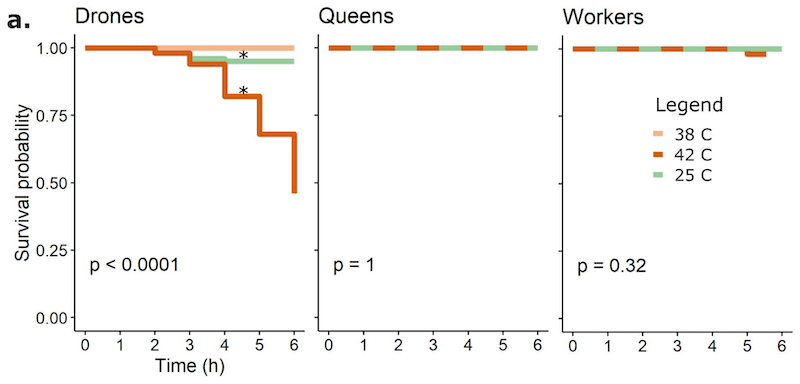
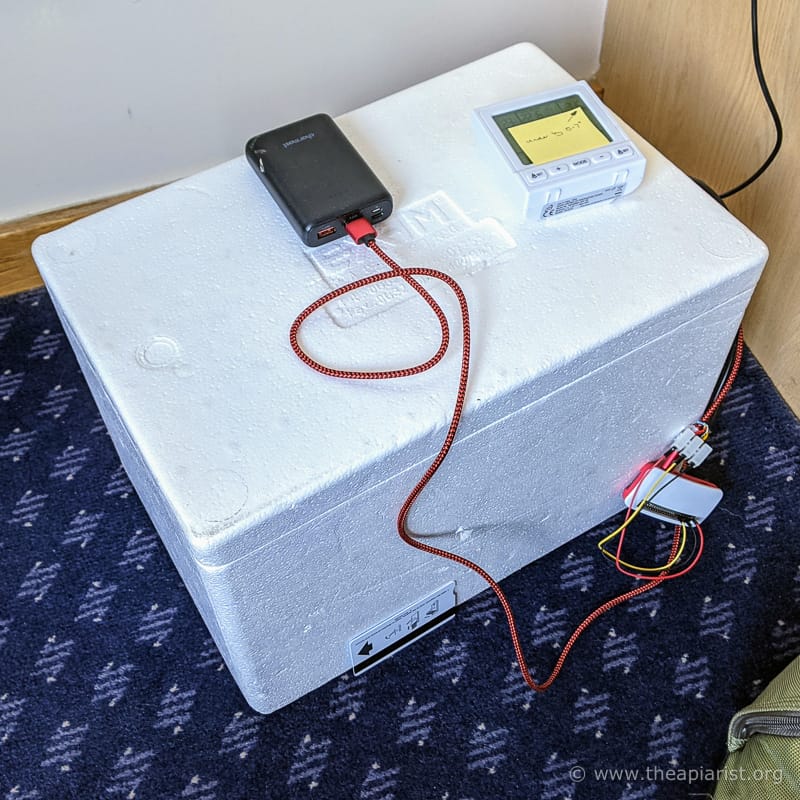
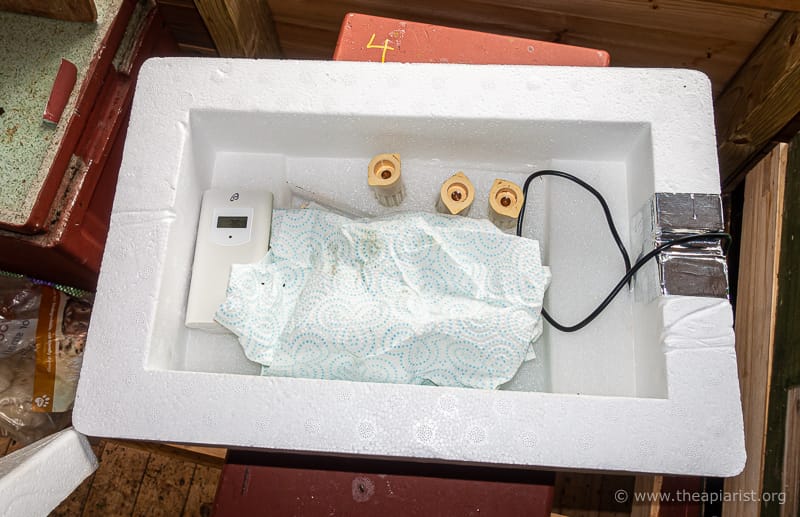
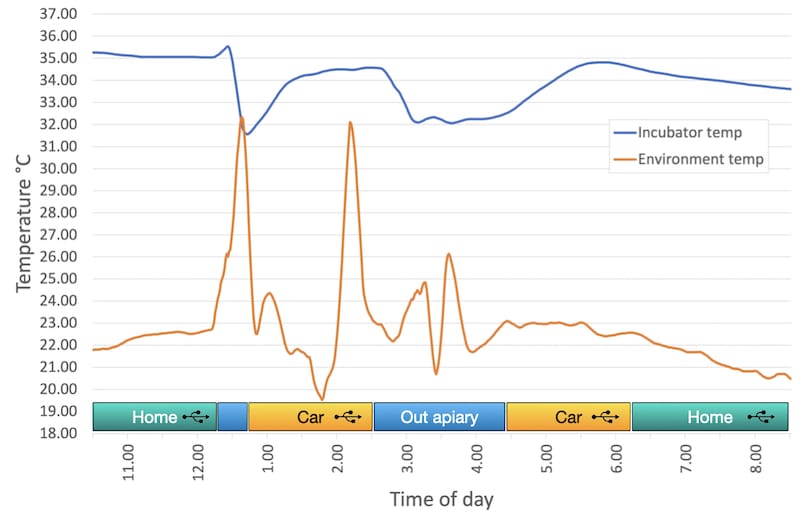
Join the discussion ...